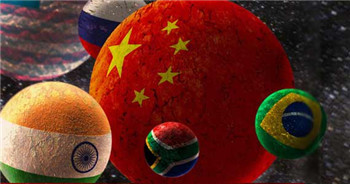(单词翻译:单击)

The leaders of the Brics – Brazil, Russia, India, China and South Africa – held their seventh annual summit amid deep scepticism about their once-promising growth story. While Russia may have been the host of the show, the real engine behind the summit, and the changes taking place across the emerging world, is China.
金砖国家(Brics,指巴西、俄罗斯、印度、中国和南非5国)领导人刚刚举行了第七届年度峰会,此际外界对于这些国家曾经颇有希望的增长故事持严重怀疑态度。尽管俄罗斯是东道主,但此次峰会以及整个新兴市场发生的变革背后,真正的引擎是中国。
Right now, the Brics face serious cyclical and structural challenges and India seems to be the only bright spot in the club. Russia, Brazil and South Africa are either in recession or dangerously close to it. China is struggling to maintain its growth momentum as it tries to rebalance its economy. All need to implement deep and difficult structural reforms if they want to increase their long term growth potential and live up to the Brics dream as it was envisioned in the early 2000s.
目前,金砖国家面临严重的周期性和结构性挑战,印度似乎是唯一的亮点。俄罗斯、巴西和南非要么正处于衰退,要么正危险地逼近衰退。中国正在努力实现经济转型之际艰难保持其增长势头。要想提高长期增长潜力,并实现金砖国家在本世纪初提出的梦想,所有这些国家都需要实行深刻且艰难的结构性改革。
Yet, over the last 15 years, the Brics story has been little short of spectacular. In 2001, when the term was coined, their combined GDP was a quarter of that of the US. Now, it is almost on a par. What was little more than a loose concept has given rise to institutions such as the Brics Bank and the Contingent Reserve Agreement. Regular dialogue is taking place among the five countries above and beyond their regular summits.
然而,过去15年,金砖国家的故事并不缺少壮举。2001年,当“金砖国家”这个词首次出现时,这些国家的国内生产总值(GDP)总额为美国的四分之一。如今,它们几乎可与美国比肩。这个不过是个松散概念的词汇,促成了“金砖银行”(Brics Bank)以及应急储备安排(Contingent Reserve Agreement)等机制的诞生。除了定期峰会以外,金砖5国还在定期举行对话。
But the Brics are not a club of equals and their balance of power has changed radically over time. China’s GDP is now almost 60 per cent larger than the other four countries combined. In 2001, it was 10 per cent smaller. More importantly, and in a stark departure from its usual restraint, China has decided to play a more assertive role in the pursuit of its global financial agenda. Indeed, 2015 is likely to go down in the financial history books as the year when China awoke.
但金砖5国的实力并不均衡,随着时间的流逝,它们的力量平衡发生了彻底的变化。中国的GDP现在比其他4国的GDP总和高出近60%。2001年,中国的GDP比其他4国GDP总和低10%。更重要的是,与往常的低调迥然不同的是,中国决定在实现其全球金融议程的过程中扮演更强硬角色。实际上,2015年可能会成为金融史上中国觉醒的一年。
This change of attitude is partly due to the frustration caused by a lack of progress in reforming the Bretton Woods institutions, and particularly by Washington’s continued inability to ratify reforms that were supposed to give additional IMF voting rights to emerging countries, most notably to China which currently has less voting rights than the Benelux countries.
这种态度的转变在一定程度上源于对布雷顿森林(Bretton Woods)机构改革缺乏进展感到失望,尤其是美国一直没能批准将国际货币基金组织(IMF)更多投票权赋予新兴国家的改革措施,特别是赋予中国更多投票权,中国目前的投票权低于比利时、荷兰和卢森堡三国之和。
Faced with such paralysis, at a time when development banks are more needed than ever to tackle the challenges of infrastructure and sustainable development finance, China has decided to organize things for itself and to promote a set of new financial institutions. Three have been formally established: the Asian Infrastructure Investment Bank, which has been capitalized with $100bn dollars and is headquartered in Beijing; the New Development Bank (Brics Bank), based in Shanghai and with starting capital of $50bn; and an associated Contingent Reserve Arrangement of $100bn, which will receive up to $41bn from China.
面对这种无所作为,在全球比任何时候都更需要开发银行,来解决基础设施和可持续开发性金融面临的挑战之际,中国决定自己组织力量,推动一系列新的金融机构的设立。中国已正式创建了3个机构:亚洲基础设施投资银行(AIIB),法定资本为1000亿美元,总部位于北京;新开发银行(New Development Bank,即“金砖银行”),总部设在上海,初始资本为500亿美元;以及配套的应急储备安排,规模为1000亿美元,中国最高出资410亿美元。
In addition is a Silk Road fund with $40bn of capital put up exclusively by China. It will be used for equity investments in infrastructure projects on land and sea that, like the old Silk Road, will further connect China with Central Asia, the Middle East, Africa, Europe and beyond.
此外还有总规模为400亿美元的丝路基金(Silk Road fund),完全由中国出资。该基金将用于陆地和海上基础设施项目的股权投资,与过去的“丝绸之路”一样,这些设施将进一步加强中国与中亚、中东、非洲、欧洲以及其他国家的联系。
China, then, is spearheading the development of a group of institutions within the region and more broadly within emerging markets that will contribute to financing economic development and to sustaining financial and commercial dynamism. If they are successful, these institutions will increase the potential growth rate of the region, will consolidate China’s central role in it and will help the country find new engines of growth at a time when its traditional engines are sputtering.
因此,中国正在引领本地区以及更广泛的新兴市场内一系列机构的发展,这将有助于为它们的经济发展提供资金,以及维持金融和商业动力。如果取得成功,这些机构将推升该地区的潜在增长率,巩固中国在该地区的主导角色,并将有助于中国在传统增长引擎失灵之际找到新的增长引擎。
To strengthen the entire architecture, Beijing is determined to give the renminbi a central role as a trade and investment currency. In the last five years, tremendous progress has been achieved on this front. From virtually zero, 25 per cent of China’s international trade and 30 per cent of its direct investment abroad are now denominated in renminbi. The renminbi has become one of the most widely used currencies, particularly in Asia. To facilitate its use and to ensure its liquidity, China has signed currency swap agreements with close to 30 countries and has set up RMB clearing centres on all continents. Finally, China has forcefully expressed its wish that its currency should be included in the SDR basket as part of the ongoing revision process to accelerate its rise as a reserve currency. The infrastructure underpinning the internationalization of the renminbi is rapidly taking shape across the world and will culminate with its wide acceptance as a reserve currency.
为了加强整体架构,中国政府决心让人民币成为主要的贸易和投资货币。在过去5年里,中国在这方面取得了巨大进展。在中国的国际贸易和对外直接投资中,以人民币计价的比例从基本上为零分别上升至25%和30%。人民币已经成为全球(尤其是在亚洲)使用最广的货币之一。为了方便人民币的使用并确保其流动性,中国与近30个国家签署了货币互换协议,并在所有大陆建立了人民币清算中心。最后,中国强烈表达了希望人民币被纳入特别提款权(SDR)货币篮子的愿望,这是中国加快让人民币成为储备货币的持续修正过程的一部分。支持人民币国际化的基础设施迅速在世界各地成型,并将随着人民币被广泛接受为储备货币而达到顶峰。
This being China, there is an element of pragmatism in the promotion of these institutions. China is seeding different entities and will likely provide the greatest support over time to the ones that, by its own criteria, are the most successful. For the time being, there is clearly a coincidence of interests among the Brics and Chinese dominance serves the other members well, as does the creation of an alternative system to Bretton Woods. The mobilisation of capital to spur their development and strengthen their resilience is very welcome at a time when liquidity is likely to become tighter and, in the case of Russia, sanctions are biting. Over the longer term, however, Chinese dominance over the Brics will likely create tensions as significant strategic differences between the members become more visible.
由于背后是中国,因此这些机构所得到的推动有务实的色彩。中国正在培育不同的实体,并很可能随着时间推移,对按自己标准衡量最为成功的那些机构提供最大的支持。就现在而言,金砖国家的利益显然保持一致,中国占据主导地位也很符合其他成员国的利益,创建一个替代布雷顿森林体系的体系也是如此。在流动性可能紧缩、俄罗斯遭受制裁之际,调动资本支持各国发展并增强它们的适应力,受到热烈欢迎。然而,就更长期而言,随着各成员国的巨大战略差异变得日益明显,中国在金砖国家中占据主导地位可能导致紧张局势。
Yet the historical importance of these developments should not be missed. As China lays out a web of new trade and capital routes which connect Asia with the Middle East, Africa and Latin America, it positions itself at the centre of a new growth dynamic linking 85 per cent of the world’s population.
然而,我们不应忽视这些发展在历史上的重要意义。随着中国设计出将亚洲与中东、非洲和拉美连接起来的新的贸易和资本路线图网络,中国正将自己定位于连接全球85%人口的新增长动力的中心。


